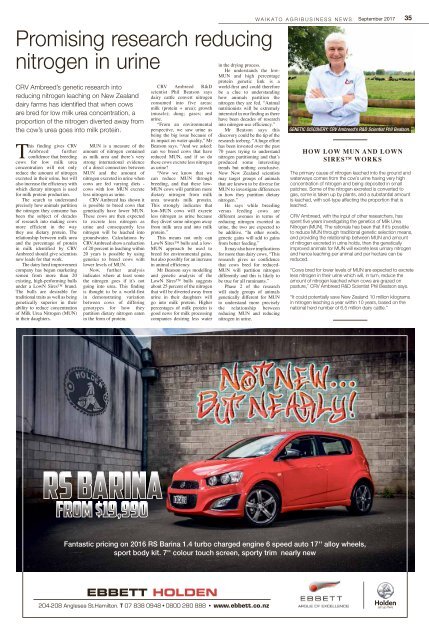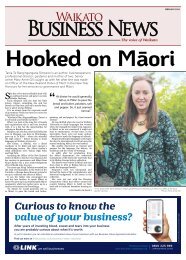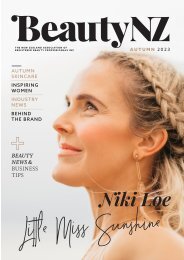AgriBusiness News September 2017
The publication profiling the best in agribusiness in Waikato. NZ businesses are helping Waikato farmers thrive through research, development and innovation – from identifying farmers’ needs to designing, developing and commercialising unique solutions to help them.
The publication profiling the best in agribusiness in Waikato. NZ businesses are helping Waikato farmers thrive through research, development and innovation – from identifying farmers’ needs to designing, developing and commercialising unique solutions to help them.
- No tags were found...
Create successful ePaper yourself
Turn your PDF publications into a flip-book with our unique Google optimized e-Paper software.
WAIKATO AGRIBUSINESS NEWS <strong>September</strong> <strong>2017</strong> 35<br />
Promising research reducing<br />
nitrogen in urine<br />
CRV Ambreed’s genetic research into<br />
reducing nitrogen leaching on New Zealand<br />
dairy farms has identified that when cows<br />
are bred for low milk urea concentration, a<br />
proportion of the nitrogen diverted away from<br />
the cow’s urea goes into milk protein.<br />
This finding gives CRV<br />
Ambreed further<br />
confidence that breeding<br />
cows for low milk urea<br />
concentration will not only<br />
reduce the amount of nitrogen<br />
excreted in their urine, but will<br />
also increase the efficiency with<br />
which dietary nitrogen is used<br />
for milk protein production.<br />
The search to understand<br />
precisely how animals partition<br />
the nitrogen they consume has<br />
been the subject of decades<br />
of research into making cows<br />
more efficient in the way<br />
they use dietary protein. The<br />
relationship between milk urea<br />
and the percentage of protein<br />
in milk identified by CRV<br />
Ambreed should give scientists<br />
new leads for that work.<br />
The dairy herd improvement<br />
company has begun marketing<br />
semen from more than 20<br />
existing, high-performing bulls<br />
under a LowN Sires brand.<br />
The bulls are desirable for<br />
traditional traits as well as being<br />
genetically superior in their<br />
ability to reduce concentration<br />
of Milk Urea Nitrogen (MUN)<br />
in their daughters.<br />
MUN is a measure of the<br />
amount of nitrogen contained<br />
as milk urea and there’s very<br />
strong international evidence<br />
of a direct connection between<br />
MUN and the amount of<br />
nitrogen excreted in urine when<br />
cows are fed varying diets -<br />
cows with low MUN excrete<br />
less nitrogen as urine.<br />
CRV Ambreed has shown it<br />
is possible to breed cows that<br />
genetically have lower MUN.<br />
These cows are then expected<br />
to excrete less nitrogen as<br />
urine and consequently less<br />
nitrogen will be leached into<br />
groundwater. Calculations by<br />
CRV Ambreed show a reduction<br />
of 20 percent in leaching within<br />
20 years is possible by using<br />
genetics to breed cows with<br />
lower levels of MUN.<br />
Now, further analysis<br />
indicates where at least some<br />
the nitrogen goes if it’s not<br />
going into urea. This finding<br />
is thought to be a world-first<br />
in demonstrating variation<br />
between cows of differing<br />
genotypes for how they<br />
partition dietary nitrogen eaten<br />
in the form of protein.<br />
CRV Ambreed R&D<br />
scientist Phil Beatson says<br />
dairy cattle convert nitrogen<br />
consumed into five areas:<br />
milk (protein + urea); growth<br />
(muscle); dung; gases; and<br />
urine.<br />
“From an environmental<br />
perspective, we saw urine as<br />
being the big issue because of<br />
its impact on water quality,” Mr<br />
Beatson says. “And we asked:<br />
can we breed cows that have<br />
reduced MUN, and if so do<br />
these cows excrete less nitrogen<br />
as urine?<br />
“Now we know that we<br />
can reduce MUN through<br />
breeding, and that these low-<br />
MUN cows will partition more<br />
dietary nitrogen from milk<br />
urea towards milk protein.<br />
This strongly indicates that<br />
low-MUN cows will excrete<br />
less nitrogen as urine because<br />
they divert some nitrogen away<br />
from milk urea and into milk<br />
protein.”<br />
This means not only can<br />
LowN Sires bulls and a low-<br />
MUN approach be used to<br />
breed for environmental gains,<br />
but also possibly for an increase<br />
in animal efficiency.<br />
Mr Beatson says modelling<br />
and genetic analysis of the<br />
LowN Sires bulls suggests<br />
about 25 percent of the nitrogen<br />
that will be diverted away from<br />
urine in their daughters will<br />
go into milk protein. Higher<br />
percentages of milk protein is<br />
good news for milk processing<br />
companies desiring less water<br />
in the drying process.<br />
He understands the low-<br />
MUN and high percentage<br />
protein genetic link is a<br />
world-first and could therefore<br />
be a clue to understanding<br />
how animals partition the<br />
nitrogen they are fed. “Animal<br />
nutritionists will be extremely<br />
interested in our finding as there<br />
have been decades of research<br />
into nitrogen-use efficiency.”<br />
Mr Beatson says this<br />
discovery could be the tip of the<br />
research iceberg. “A huge effort<br />
has been invested over the past<br />
70 years trying to understand<br />
nitrogen partitioning and that’s<br />
produced some interesting<br />
trends but nothing conclusive.<br />
Now New Zealand scientists<br />
may target groups of animals<br />
that are known to be diverse for<br />
MUN to investigate differences<br />
in how they partition dietary<br />
nitrogen.”<br />
He says while breeding<br />
versus feeding cows are<br />
different avenues in terms of<br />
reducing nitrogen excreted as<br />
urine, the two are expected to<br />
be additive. “In other words,<br />
genetic gains will add to gains<br />
from better feeding.”<br />
It may also have implications<br />
for more than dairy cows. “This<br />
research gives us confidence<br />
that cows bred for reduced-<br />
MUN will partition nitrogen<br />
differently and this is likely to<br />
be true for all ruminants.”<br />
Phase 2 of the research<br />
will study groups of animals<br />
genetically different for MUN<br />
to understand more precisely<br />
the relationship between<br />
reducing MUN and reducing<br />
nitrogen in urine.<br />
GENETIC DISCOVERY: CRV Ambreed’s R&D Scientist Phil Beatson.<br />
HOW LOW MUN AND LOWN<br />
SIRES WORKS<br />
The primary cause of nitrogen leached into the ground and<br />
waterways comes from the cow’s urine having very high<br />
concentration of nitrogen and being deposited in small<br />
patches. Some of the nitrogen excreted is converted to<br />
gas, some is taken up by plants, and a substantial amount<br />
is leached, with soil-type affecting the proportion that is<br />
leached.<br />
CRV Ambreed, with the input of other researchers, has<br />
spent five years investigating the genetics of Milk Urea<br />
Nitrogen (MUN). The rationale has been that if it’s possible<br />
to reduce MUN through traditional genetic selection means,<br />
and providing the relationship between MUN and amount<br />
of nitrogen excreted in urine holds, then the genetically<br />
improved animals for MUN will excrete less urinary nitrogen<br />
and hence leaching per animal and per hectare can be<br />
reduced.<br />
“Cows bred for lower levels of MUN are expected to excrete<br />
less nitrogen in their urine which will, in turn, reduce the<br />
amount of nitrogen leached when cows are grazed on<br />
pasture,” CRV Ambreed R&D Scientist Phil Beatson says.<br />
“It could potentially save New Zealand 10 million kilograms<br />
in nitrogen leaching a year within 10 years, based on the<br />
national herd number of 6.5 million dairy cattle.”<br />
NEW MID-SIZE<br />
MALIBU CD PETROL<br />
from rsp<br />
$<br />
33,990<br />
+on roads<br />
CRUZE EQUIPE<br />
1.8L SEDAN AUTO<br />
from rsp<br />
$<br />
25,990<br />
+on roads<br />
COLORADO 4X2<br />
CREWCAB AUTO<br />
from rsp<br />
$<br />
39,990<br />
+on roads<br />
<strong>2017</strong> HOLDEN COLORADO<br />
The Holden Colorado range is a lot of ute for a tiny price. You get 3.5 tonne towing<br />
power, electric power steering, Apple® CarPlay and Android® Auto technology<br />
and car-like comfort all round.<br />
Fantastic pricing on 2016 RS Barina 1.4 turbo charged engine 6 speed auto 17'' alloy wheels,<br />
sport body kit. 7'' colour touch screen, sporty trim nearly new<br />
1% Fixed annual interest, no deposit required, 36 month term. While stocks last on new Holden Colorado purchases registered by 31/08/<strong>2017</strong>.<br />
Not available with any other offer. Heartland Bank Limited’s lending criteria, terms and conditions and fees apply, including establishment fees of $656<br />
THESE DEALS ARE AS GOOD AS THEY GET<br />
EBBETT HOLDEN<br />
204-208 Anglesea St.Hamilton. T 07 838 0948 • 0800 280 888 • www.ebbett.co.nz<br />
204-208 PukekoheAnglesea St, Hamilton, T 07 838 Tauranga 0949<br />
Taupo<br />
Cnr Edinburgh & Tobin Sts<br />
09 237 0710<br />
204 – 208 Anglesea St<br />
07 838 0949<br />
Cnr Cameron Road & Wharf St<br />
07 578 2843<br />
Cnr Paora Hapi & Ruapehu Sts<br />
07 378 4130<br />
5965158AA<br />
FINANCE<br />
www.ebbett.co.nz<br />
Offer available while stocks last. Offers end April 30th 2014. Not available with<br />
other offers. Private customers only.


















